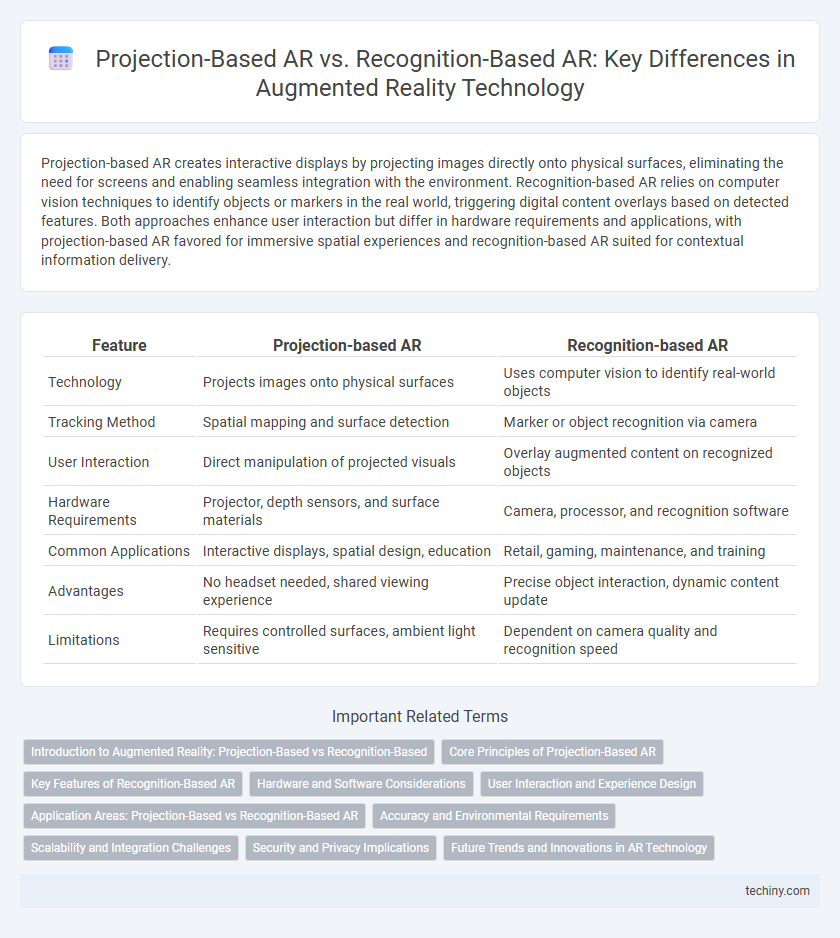Projection-based AR creates interactive displays by projecting images directly onto physical surfaces, eliminating the need for screens and enabling seamless integration with the environment. Recognition-based AR relies on computer vision techniques to identify objects or markers in the real world, triggering digital content overlays based on detected features. Both approaches enhance user interaction but differ in hardware requirements and applications, with projection-based AR favored for immersive spatial experiences and recognition-based AR suited for contextual information delivery.
Table of Comparison
| Feature | Projection-based AR | Recognition-based AR |
|---|---|---|
| Technology | Projects images onto physical surfaces | Uses computer vision to identify real-world objects |
| Tracking Method | Spatial mapping and surface detection | Marker or object recognition via camera |
| User Interaction | Direct manipulation of projected visuals | Overlay augmented content on recognized objects |
| Hardware Requirements | Projector, depth sensors, and surface materials | Camera, processor, and recognition software |
| Common Applications | Interactive displays, spatial design, education | Retail, gaming, maintenance, and training |
| Advantages | No headset needed, shared viewing experience | Precise object interaction, dynamic content update |
| Limitations | Requires controlled surfaces, ambient light sensitive | Dependent on camera quality and recognition speed |
Introduction to Augmented Reality: Projection-Based vs Recognition-Based
Projection-based AR employs spatial light projection to overlay digital images directly onto physical surfaces, creating interactive environments without the need for screen devices. Recognition-based AR utilizes image recognition technologies, such as markers or natural feature tracking, to identify objects and trigger corresponding virtual content via cameras or sensors. Both methods enhance user experience by blending digital information with the real world, but differ in their technological approach and application scenarios.
Core Principles of Projection-Based AR
Projection-based AR operates by directly projecting digital images onto physical surfaces, enabling users to interact with augmented content without wearable devices. Core principles include spatial mapping to identify suitable surfaces, precise light projection to ensure image clarity, and real-time environmental adaptation to maintain alignment with physical objects. This approach enhances user immersion by seamlessly blending virtual visuals with the tangible world through light and surface interactivity.
Key Features of Recognition-Based AR
Recognition-based AR utilizes computer vision technologies to identify specific objects or images in the real world, enabling dynamic digital content overlay. Key features include image tracking, pattern recognition, and marker detection, allowing precise alignment of virtual elements with physical objects. This approach offers enhanced interactivity and context-aware experiences by responding to recognized objects in real-time environments.
Hardware and Software Considerations
Projection-based AR relies on advanced projection hardware such as lasers and microprojectors to overlay images directly onto physical surfaces, requiring precise calibration and surface detection software. Recognition-based AR depends heavily on powerful cameras and image recognition algorithms running on devices like smartphones or AR glasses to identify markers or environments for digital content placement. Both approaches demand optimized processing units and sensor integration, but projection-based systems emphasize light output and alignment hardware while recognition-based systems prioritize real-time image processing and machine learning models.
User Interaction and Experience Design
Projection-based AR enhances user interaction by directly overlaying digital content onto physical surfaces, allowing intuitive, spatially-aware experiences without the need for handheld devices. Recognition-based AR relies on identifying predefined markers or objects, offering interactive content triggered by visual cues but often limiting spontaneous user engagement. Designing for projection-based AR focuses on seamless environmental integration and natural gestures, whereas recognition-based AR emphasizes marker accuracy and contextual awareness to optimize user experience.
Application Areas: Projection-Based vs Recognition-Based AR
Projection-based AR excels in interactive installations, manufacturing, and medical visualization by projecting images directly onto physical surfaces for intuitive user engagement. Recognition-based AR dominates retail, education, and gaming through real-time object or image recognition, enabling dynamic digital overlays on smartphones and AR glasses. Both technologies enhance user experience by merging digital content with the real world but cater to different application needs based on interaction style and environment.
Accuracy and Environmental Requirements
Projection-based AR offers high spatial accuracy by directly projecting images onto physical surfaces, enabling precise alignment without relying heavily on environmental features. Recognition-based AR depends on image recognition algorithms that require distinct visual markers or textured surfaces, which can limit accuracy in cluttered or uniform environments. Environmental requirements for projection-based AR include adequate surface properties and lighting conditions, while recognition-based AR necessitates well-defined, stable visual inputs for consistent tracking performance.
Scalability and Integration Challenges
Projection-based AR faces scalability challenges due to the complexity of accurately projecting images onto diverse surfaces in varying environments, limiting its adaptability across multiple settings. Recognition-based AR relies on image or object recognition algorithms that can scale more efficiently but demands robust data processing and extensive training datasets to integrate seamlessly with diverse hardware platforms. Integration of projection-based AR often requires specialized projection hardware, whereas recognition-based AR benefits from widespread camera and sensor availability, enhancing its potential for broader application and scalable deployment.
Security and Privacy Implications
Projection-based AR projects images onto physical surfaces, minimizing data collection and reducing privacy risks by avoiding extensive user data capture. Recognition-based AR relies on scanning and identifying objects or environments, which can raise security concerns due to the storage and processing of sensitive visual information. Implementing strong encryption and access controls is essential in recognition-based AR to protect user privacy and prevent unauthorized data breaches.
Future Trends and Innovations in AR Technology
Projection-based AR is expected to evolve with advancements in holographic displays and spatial light modulation, enabling more immersive and interactive environments without the need for handheld devices. Recognition-based AR will benefit from improvements in AI-driven computer vision and neural networks, allowing faster and more accurate object and scene understanding for dynamic, real-time applications. Future innovations will integrate these technologies, creating seamless augmented experiences that adapt to user context and environmental changes.
Projection-based AR vs Recognition-based AR Infographic

 techiny.com
techiny.com